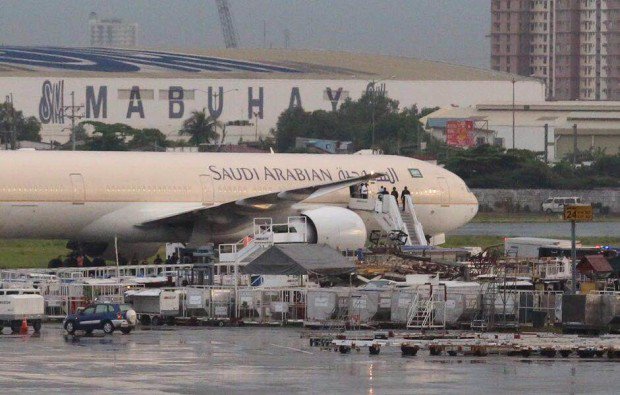
The special operations unit of the Philippine National Police aviation security group conducts clearing operations around the isolated Saudia airplane at the Ninoy Aquino International Airport on Tuesday (Sept. 20, 2016). JOAN BONDOC/INQUIRER
IT WAS pilot error and not a hijacking that caused a Saudia Airlines flight from Jeddah to raise a security alarm at the Ninoy Aquino International Airport (Naia) on Tuesday afternoon.
Airport authorities ordered Saudia Airlines flight SV 872 to roll to an isolated area off the runway where security forces could assess the situation.
The unidentified Saudia pilot reportedly triggered a “hijacking” alert while the plane was 20 miles from the Naia at around 2 p.m.
Manila International Airport Authority (MIAA) General Manager Ed Monreal said “it was accidental.” But he said the pilot was under investigation for the incident because “the problem is it was pushed twice.”
400 returning Filipino hajjis
The alert caused the Manila control tower to advise Naia security that the flight was under threat. The plane had over 400 returning Filipino hajj pilgrims on board.
“The MIAA together with the Aviation Security Group immediately responded and designated an isolation site at the rapid exit area near main runway 06/24,” Monreal said.
Airport Emergency Plan 4, the MIAA strategy for a hijacking, was immediately put into action, he added.
Although the incident was eventually attributed to the pilot mistakenly pushing the panic button, Monreal said it still had to be properly investigated.
According to the Civil Aviation Authority of the Philippines, the Saudi pilot sent a distress signal to the Manila area control center at 2:13 p.m., squawking 7500, the code announcing a hijacking in progress.
The flight was given priority landing by airport authorities at 2:38 p.m. and was directed to park in a remote bay and isolated for security procedures.
Finally, at around 5 p.m., the passengers were allowed to disembark in batches and taken on shuttle buses to Gate 15 at Naia Terminal 1.
A passenger, who asked not to be identified, said they were surprised when the plane just parked near the runway.
“We were not told anything. We were instructed to take out our passports because some officials were boarding to verify our travel documents,” she told the Inquirer.
She said the flight attendants also did not seem to know what was going on. “We were there for about two hours and they too did not seem to know anything.”
Prior to the arrival of the Saudia flight, immigration personnel were preparing to conduct an operation to weed out “fake Filipinos” among the passengers returning from the pilgrimage to Mecca.
The “fake Filipinos” were supposedly foreigners using Philippine-issued hajj passports. A source said there was information four of the foreigners might have had links to a terror group.